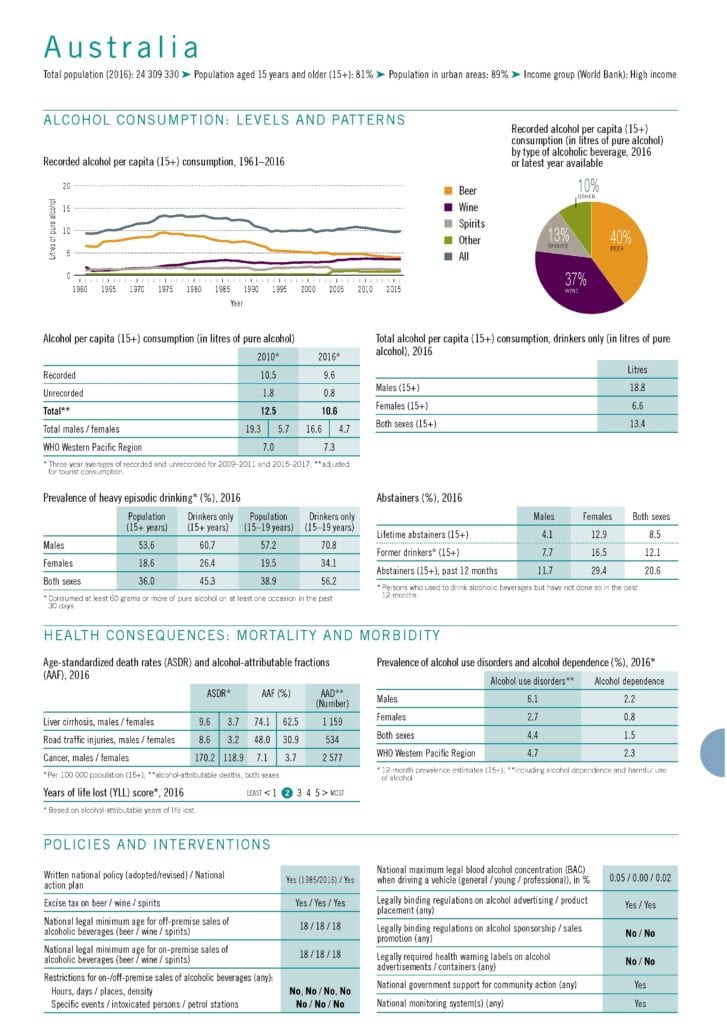Australia: Improved Alcohol Consumption Guidelines
Australia has released improved alcohol consumption guidelines for the first time since 2009.
The National Health and Medical Research Council (NHMRC) published a draft report which updated Australia’s alcohol guidelines. This is the first time the guidelines have been updated since 2009.
Even though it has already been scientifically proven that no amount of alcohol is safe and completely risk-free for consumption, governments issue guidelines for alcohol use with the hopes of reducing the risk faced by people who use alcohol.
It’s 10 years since our last review of the guidelines and we now know more about the effects of alcohol. We know that alcohol continues to have significant direct health consequences for many Australians,” said Anne Kelso, the NHMRC chief executive, as per The Guardian.
After three years of research into the subject of alcohol harms, the NHMRC has found that the lifetime risk of dying from alcohol-related disease or injury remained below 1 in 100 if alcohol consumption stayed below 10 units per week. Hence, the new guidelines advice, no more than 10 standard units of alcohol per week and no more than 4 standard units in a single sitting.
The NHMRC’s research also found greater certainty about links between alcohol and a number of different cancers.
Additionally, the new guidelines state, people under the age of 18, women who are pregnant or are planning for pregnancy should not have alcohol at all and for women who are breastfeeding zero alcohol is safest for the baby.
While the guideline does not highlight paternal alcohol consumption risk to a developing fetus, IOGT International recently reported evidence which found that paternal as well as maternal alcohol exposure increased the chance a baby will develop congenital heart disease. This is an addition which can further improve the guidelines and safeguard children from alcohol harm.
Alcohol harm in Australia
According to health data, there were more than 4,000 alcohol-related deaths in Australia in 2017 and more than 70,000 hospital admissions during the 2016-17 financial year.
The total per capita alcohol consumption in Australia, as reported by the WHO, is at 10.6 litres which is above the average for the WHO Western-Pacific Region. Binge alcohol use is also high among Australian youth with over half (56.2%) of youth between 15 to 19 years who use alcohol engaging in this harmful behavior.
Alcohol harm is obvious with alcohol causing over 2500 cancer deaths, over 1000 deaths from liver cirrhosis and over 500 deaths from road traffic injury in Australia.
While the new guidelines help raise awareness of the risk associated with alcohol use, Australia needs to strengthen their alcohol control policy to prevent and reduce alcohol harm in the long run through evidence-based population-level measures. Currently, Australia does not have restrictions on/off premise sale of alcohol or regulations on alcohol sponsorship for instance.
Alcohol advertising regulation in Australia is largely through the alcohol industry’s own rules and codes of conduct. But this scheme of self-regulation has been found to be a failure in protecting children and the public from alcohol harm. In terms of pregnancy warning labels – which were recently drafted as well – Big Alcohol is putting up an aggressive opposition.
The government needs to take action to strengthen alcohol policy and safeguard policies from vested interests such as the alcohol industry for the safety of the Australian people.
